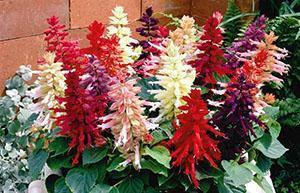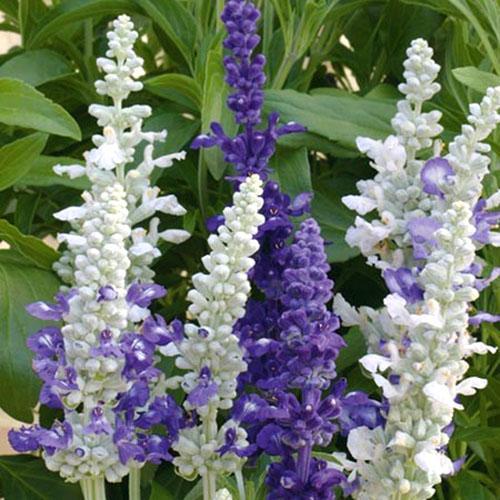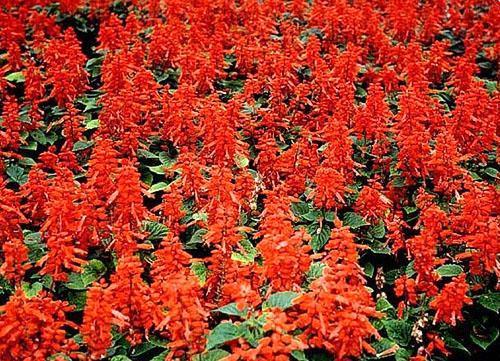We grow salvia from seeds for summer cottages
 The zenith of summer has come, and every plant seeks to declare itself. Flowering is a continuation of the genus. To bloom, nourish the seeds with vitality and go into the shadows, giving way to a new generation. Salvia opens its panicle of tubular flowers at the height of summer, when pollinators with long proboscis are most active. With her victorious bloom, she fascinates and delights. How to grow salvia, create a composition?
The zenith of summer has come, and every plant seeks to declare itself. Flowering is a continuation of the genus. To bloom, nourish the seeds with vitality and go into the shadows, giving way to a new generation. Salvia opens its panicle of tubular flowers at the height of summer, when pollinators with long proboscis are most active. With her victorious bloom, she fascinates and delights. How to grow salvia, create a composition?
The origin and cultivation of salvia

The plant in many species is cultivated and is a wild plant in the vastness of America and Europe. The numerous genus is represented by more than 900 different varieties. There is even a hallucinogenic variety among the salvias. The plant loves bright places and light soils.
Planting and caring for salvia
 Urban landscaping cannot do without salvia for many reasons:
Urban landscaping cannot do without salvia for many reasons:
- Salvia blooms continuously and throughout the warm period until frost.
- An excellent ornamental plant does not grow and keeps the created composition well.
- Gas pollution from transport does not affect the decorativeness of the plant.
- By choosing different shades of inflorescences, you can create any composition.
But gardeners who start sowing salvia at home when winter is just in full swing love the plant no less. In addition to the victorious scarlet color, salvia panicles amaze with a variety of tones. You can make a multilevel planting by picking up the salvia according to the height of the bushes. But the main step for obtaining long-term flowering will be the cultivation of salvia seedlings.
How and when to sow salvia seedlings
 The seed plant blooms in the fourth month and is therefore only grown as an annual crop through sowing in February or early March. Salvia seeds can be bought at a specialty store, or you can get it yourself. They ripen after the flower falls in 50 days. Seed germination lasts up to 5 years.
The seed plant blooms in the fourth month and is therefore only grown as an annual crop through sowing in February or early March. Salvia seeds can be bought at a specialty store, or you can get it yourself. They ripen after the flower falls in 50 days. Seed germination lasts up to 5 years.
Still, it is better to buy varietal seeds in specialized stores.
Before sowing seeds, it is necessary to prepare the land for seedlings. It should be light and nutritious. Two weeks before sowing salvia for seedlings, the soil should be treated with a composition that increases the biological processes in the sleeping earth. Sift the earth, moisten and add a teaspoon of EM-1 Baikal to a bucket of earth. The earth in warmth will become fertile in two weeks, and at the same time filamentous seedlings of weeds will come out, the seeds of which will inevitably hatch in living earth.
Place the prepared soil box in the pallet, level and sow small salvia seeds mixed with sand for more even distribution. In order to press the seeds to the ground, moisten the ground with a fine spray from above and cover the surface to retain moisture. Planting and caring for salvia during seed germination is crucial for the further production of healthy seedlings.
 Seedlings will appear in 10-14 days. It is necessary to monitor the condition of the earth at this time, preventing the coma from drying out.Watering must be carried out through the pallet. The earth through the drainage holes is saturated with moisture, then drain the water from the sump so that there is no excess moisture.
Seedlings will appear in 10-14 days. It is necessary to monitor the condition of the earth at this time, preventing the coma from drying out.Watering must be carried out through the pallet. The earth through the drainage holes is saturated with moisture, then drain the water from the sump so that there is no excess moisture.
During the germination period, prevent the plants from pulling into a string and lodging.
Seedlings in the cotyledon stage can stretch out if they are in a shaded place or high night temperatures. Then you should add earth to each sprout, preventing it from falling. Watering is carried out without wetting the leaf blade. When growing salvia seedlings from seeds, this period is considered the most responsible. Backlight, reduced temperature will allow you to get strong seedlings at the first stage of planting
The picking of salvia from the seeds must be done after the appearance of two or more true leaves, while deepening the sprout to the cotyledonous leaves. The first pick can be in a common container at a distance of 5 cm between plants. The second thinning of plants is carried out a month later in separate cups, with a good capacity of an earthen coma, since they have to develop up to one and a half months.
 Whether it is necessary to feed Salvia when growing seedlings will show the condition of the plants. If the bush develops poorly, you can feed mineral composition for flowers in low concentration. But with every plant transplant, fertile land is used and nutrition should be sufficient.
Whether it is necessary to feed Salvia when growing seedlings will show the condition of the plants. If the bush develops poorly, you can feed mineral composition for flowers in low concentration. But with every plant transplant, fertile land is used and nutrition should be sufficient.
When planting and caring for salvia, you need to cause the bushiness of the plant. After the appearance of 3-4 pairs of true leaves, the top should be pinched to allow the axillary shoots to begin to develop. At the same time, it is necessary to arrange containers with plants so that there is no shading. From the end of April, the temperature at night is lowered to 10 degrees, hardening the salvia before planting in the ground.
So, in order to grow salvia seedlings from seeds, the following conditions must be met:
- prepare fertile land and quality seeds;
- observe the temperature regime and light conditions at each growth period;
- prevent overdrying and excessive moisture of the earth clod;
- while pinching the plant.
Planting salvia seedlings in the ground
 Planting and caring for salvia in the open field consists in choosing the right place for flower beds or discounts. The place should be well lit, the soil is light and fertile, with good moisture capacity. For lush flowering, you can add phosphorus-potassium fertilizers in an instant form. When planting, add a guest of ash, a spoonful of superphosphate and a liter of well-rotted organic matter to the hole. Carefully roll the bush into the ground and deepen it somewhat. Drizzle with warm water and cover from the sun for a few days until the plant takes root or is planted in cloudy weather.
Planting and caring for salvia in the open field consists in choosing the right place for flower beds or discounts. The place should be well lit, the soil is light and fertile, with good moisture capacity. For lush flowering, you can add phosphorus-potassium fertilizers in an instant form. When planting, add a guest of ash, a spoonful of superphosphate and a liter of well-rotted organic matter to the hole. Carefully roll the bush into the ground and deepen it somewhat. Drizzle with warm water and cover from the sun for a few days until the plant takes root or is planted in cloudy weather.
Plants are placed every 20-30 cm, depending on the height of the bush and its tendency to branching. Watering the plant is moderate, when the clod of earth is overdried, water-charging watering should be carried out only in the evening. The flowering of the plant occurs 100-120 days after germination and does not stop until frost. Flowering will be plentiful if foliar dressing based on EM-1 Baikal is used for prevention and to increase immunity.
Plant pests and diseases.
 Salvia is not affected by fungal diseases. Therefore, you will have to fight on the plant only with the insects that have inhabited it. Pests are whiteflies and thrips. Therefore, the salvia plantings should be kept away from vegetables, since later the whitefly will settle on them. In addition, sage can infest aphids, spider mites. At the same time, the decorativeness of plants suffers. Therefore, strong preparations are used that are best not used on vegetables during the fruiting period.
Salvia is not affected by fungal diseases. Therefore, you will have to fight on the plant only with the insects that have inhabited it. Pests are whiteflies and thrips. Therefore, the salvia plantings should be kept away from vegetables, since later the whitefly will settle on them. In addition, sage can infest aphids, spider mites. At the same time, the decorativeness of plants suffers. Therefore, strong preparations are used that are best not used on vegetables during the fruiting period.
Snails and slugs love to feed on the delicate foliage of Salvia. If they are present in the garden, then it will be a blessing not only for flowers to catch them. The classic method of bark and slate traps laid out under the bushes will help.But in a container with beer and fermented fruit juice, even neighboring mollusks can crawl.